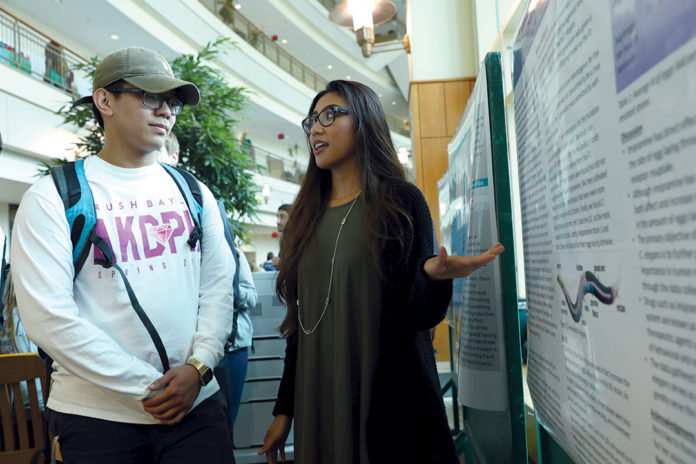
By Amanda Hargett-Granato | Reporter
Smartly dressed students stand in front of large, glossy posters. Many smile nervously, hands clasped in front of them, as their peers and professors judge the results of months of research.
Over this week, undergraduate students displayed and presented the research they’ve conducted over the last year at the Undergraduate Research and Scholarly Achievement Scholars Week. Students gave oral presentations in the Bill Daniel Student Center, while poster presentations continue through Friday in the Baylor Sciences Building.
Of those giving oral presentations, a group of students who took part in the Global Environmental Leaders Program at Hong Kong University this December prepared and presented the work they accomplished during their time in Hong Kong. Baylor students involved in the program worked with students from at least one other country to complete their research.
Pearland senior Mark McComb’s presentation focused on comparing the protection of marine ecosystems by the United States and Hong Kong. In his almost 30-minute presentation, he discussed the impact of ocean acidification, ocean warming, other threats to marine life and the ecological and economic benefits of protecting these areas.
“Development of these [Marine Protected Areas] MPAs was largely political, but their objectives are different” McComb said of the two countries’ practices. “Both countries do succeed in that their MPAs provide for sustainable fishing practices.”
Longview senior Abbey Jones used her time in Hong Kong discovering and discussing the differences between American and Hong Kong culture to shape her project.
“The program encouraged students to collaborate and discuss solutions to these pressing environmental issues,” Jones said of the Global Environmental Leaders program.
Jones turned her research toward dry land, studying the country parks of Hong Kong and the national parks in the United States. She noted in her presentation that 26 percent of the land area in Hong Kong is protected, while the U.S. protects 3.4 percent.
“[In Hong Kong] they’re very conservation minded, and I’m not sure that’s a major ideal in the U.S.,” Jones said. “It was interesting to go to Hong Kong and see these protest signs on encroaching developments. It’s very interesting from an ideological perspective.”
Jones also discussed the impact of recreation in national and country parks, which include displacing wildlife and introducing a source of pollution. However, Jones said, recreation in protected areas does allow visitors to gain an appreciation for the parks.
Wales, Wis., senior Bryce Jurss took on the task of discussing ways solid waste could be used as a resource for both countries. He discussed the importance of social movements, such as the “Don’t Mess with Texas” campaign, and government projects such as Hong Kong’s plans for composting facilities, which can be used to decrease the impact of food waste.
“We produce a lot more recyclable solid waste than we actually recycle,” Jurss said of the United States in his presentation. “So there is a lot of opportunity for ways that waste can be used as a resource, rather than just throwing it away.”
In his presentation, Jurss used examples of landfills that have been successfully developed into housing developments and even sports training complexes. Using the controversy over the expansion of the Waco landfill to make his point, Jurss suggested that reusing some of the landfill for development could ease the transition.
Poster presentations began on Tuesday and run through Friday, with biology, educational psychology and psychology/neuroscience presenting on Tuesday and Wednesday, and physics, math, chemistry and a variety of other disciplines presenting on Thursday and Friday.
One of several presenters from the Investigations of Modern Biology Concepts course, San Antonio sophomore Emily Feese, represented her research group in the atrium. Feese and her peers chose to study the effects that burn temperatures had on the growth of a specific flower, the primrose.
“It’s been really fun and informative working in this environment where you can use statistics and biology,” Feese said. “It’s been cool to see the application of all these different fields come together.”
Flower Mound sophomore Krupa George was one of several researchers covering data that was collected from the Veterans Hospital in Waco. She studied the long-term effects of blast-related traumatic brain injury in veterans and its correlation to electroencephalography readings.
“I think it’s been really empowering having a visual representation of our work,” George said. “It makes it more tangible, since usually we are just working with data.”
Also researching veterans’ issues, Amarillo junior Lauren Longcor studied the reasons behind non-suicidal self-injury in veterans who had been diagnosed with Post Traumatic Stress Disorder (PTSD). Longcor’s study suggested that not only do 15 percent of the veterans diagnosed with PTSD in the study take part in self-harm behavior, but that the actions are most strongly connected with veterans’ need to regulate their emotions.
“I had no idea before of the creative side of research,” Longcar said of developing her study. “Its cool to see in that career you have the freedom to answer questions for a population that need answering. I became invested because I can see the need that is there and how I can impact those outside of myself.”





